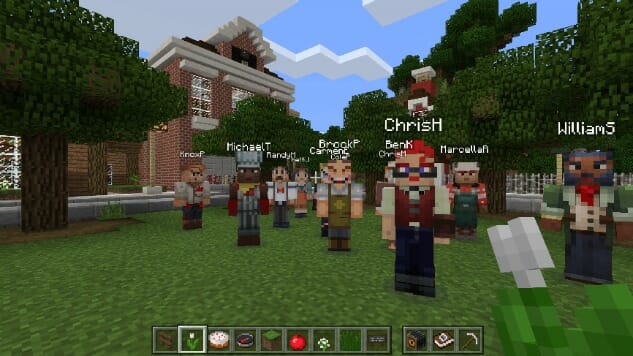Minecraft (PC)

December is a slow month for new games, so over the next few weeks we’ll look back at notable Fall releases that we haven’t reviewed yet. Today Richard Clark reviews Minecraft 1.0, which officially released in November after over two years of availability in alpha and beta form.
I spawned in the middle of an ocean, swam to shore, punched a tree a couple of times, but could make nothing actually happen. Because I didn’t realize I was supposed to hold the mouse button down, I could recover no wood. By night-fall, I was hearing groans, dodging skeleton arrows, and worst of all, growing bored. I quit, and didn’t try again for months.
But Minecraft didn’t go away, even without an official release. So many had embraced the beta that I started to wonder if I was crazy. I tried again, this time spawning on the beach armed with a tutorial and a wiki. Within the next hour I had crafted some basic tools and a shelter. It was the quintessential Minecraft introductory experience, but it felt remarkably personal.
That experience is aided by a brazenly generic graphic style: a world made of blocks calls to mind Legos before it calls to mind any particular country, time, or theme. Sporadic ambient music rings in a new dawn or warns of impending darkness. Other times it seems tied to nothing in particular, but your actions provide the music with meaning nonetheless.
In real life, I live in an apartment that was built by someone else. Throughout the day I complete tasks that are expected of me. I use my resources to pay pre-ordained bills. I interact with friends in the context of structured and scheduled gatherings. Sometimes we go take in a movie, and then we talk about that movie. Sometimes we get together and discuss an album we both listened to. Sometimes I give time to a to-do list made up of activities that I must do in order to maintain an acceptable level of cleanliness, health and financial feasibility. My life is pleasurable enough, but it’s made up of reactive, passive moments. In the midst of modern conveniences, it’s rare that I get an opportunity to create something for myself or set my own course.

The real achievement of Minecraft is how inviting and seamless it can be to build large and intricate structures. The simplistic control scheme involves simply selecting your material and right-clicking wherever you would like it to be applied. Gravity applies to very few materials, making archways and towers incredibly easy to place. Most importantly, erasing mistakes and starting over is just as easy as finishing a product. Simply mine the material, retrieve it, and place it somewhere else.
I start to think of possibilities. I think of the house I can make out of these discarded cobblestones. I discover that you can make glass and consider installing windows. I want to make a glass cathedral, a bridge across the water, a water slide. Within the second hour, without any prescribed goals or objectives, I had come up with so many ideas and ambitions that the game’s projected replay value ballooned from days, to months, to years. I’m not kidding about this: I started to look forward to playing this game with my non-existent son.
In multiplayer mode, worlds are tied to a server. The ability to have visitors, fellow citizens, and strangers drop in, look around and make a home next to yours causes a one-off randomly generated world to seem more static, familiar and reassuring. It feels an awful lot like a home away from home.
On our shared server, my friends and I had our own designated areas based not on zoning laws but an unspoken etiquette. Unlike the suburbs or cities of the physical worlds, their shape and aesthetic is dictated not by some professional architect or by the housing association, but by our individual personalities. My friend and I build a shelter together with two bedrooms, a patio on the roof, and an art gallery. A friend who takes an excessively creative approach to all of life builds an insanely large castle; an accompanying giant, glowing smiley-face can be seen from across the ocean. Another friend joins and builds a library. We discuss ways to connect our settlements: roads, rails, bridges. As we build, we joke around and discuss our lives in text chat. The awkward Minecraft avatars of our friends are imbued with emotion, imagined gestures and profound thoughts.
